The centre of Myanmar is surprisingly dry, especially in March when the weather is hot and the land is thirsty. We left the 40◦C heat of the old capital of Bagan on the Irrawaddy and travelled 60km to Mount Popa Reserve, hoping it might be cooler. From a distance, the extinct volcano was imposing but the vegetation that covered it looked tired and dusty so I wondered how much wildlife we’d see in this dry season. We arrived at the Popa Mountain Resort and entered a cool breezy garden of a hotel, shaded by big trees hopping with birds big and small.
A huge Mormon flapped down and landed on my arm. This old and battered-looking butterfly had come to slurp my sweat and this unexpected encounter confirmed that our decision to say a few nights here had been a wise one. Most tourists only drop by for lunch.
We wandered through the hotel along a boardwalk to a terrace with a fine view out of the forest that clothed the long-extinct volcano we stood on. We were at 798m above sea level and looked down and across the valley at Taung Kalat, a 200m rock tower with almost vertical sides. This was a relatively small plug of long-solidified lava that had burst out of the side of the volcano. Golden stupas glistened on its top and sounds of huge bells and gongs floated across to us.
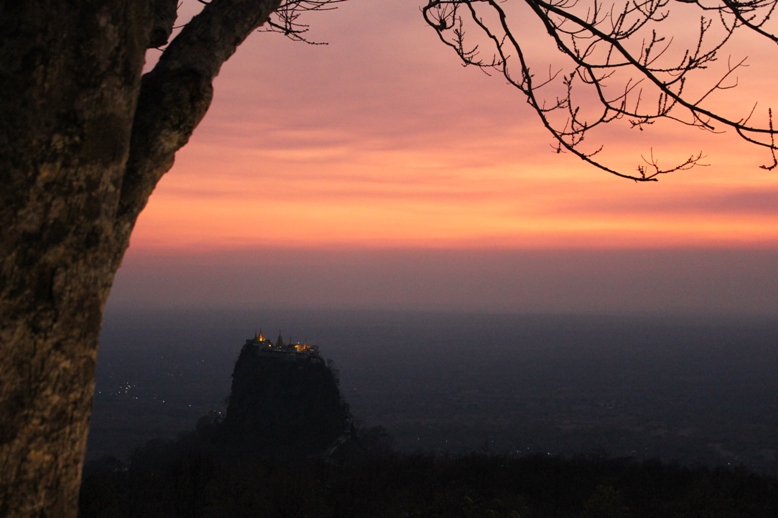 |
| Taung Kalat from Mount Popa resort |
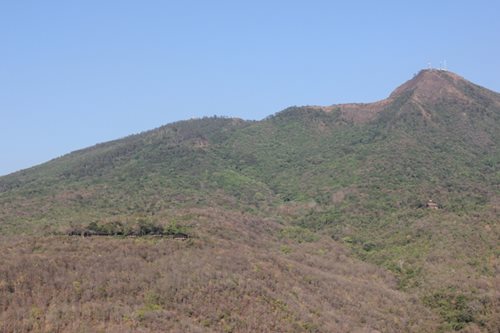 |
| The dusty dry season vegetation on Mount Popa in March; the resort is the horizontal line to the left |
Looking back, the uneven outline of the crater edge rose to 1518m. I saw S eyeing up the top of our mountain and knew we’d climb it but first we’d walk downhill towards the stupas on Taung Kalat. We took a path around the back of the hotel kitchen signposted as the trekking route. It took us steeply down through crunchy-dry forest, across a saddle of land to the base of the precipitous crag. This is home to assorted nats – unforgiving spirits capable of bringing ill fortune if not shown the proper respect. The other local residents that cause trouble are squads of delinquent rhesus monkeys. They are cruel, greedy and clever; they acted like they were Coke addicts and attempted several smash and grab assaults. One also made a snatch for a tin of sickly sweet litchi drink I was slurping. We witnessed numerous spats as one monkey would assert its dominance over a smaller troop member, and several times there were loud thuds as one fell – or was pushed – off the crag and landed on corrugated iron. The macaques were quite a distraction as we ascended the 777 steps to the summit, at 737m above sea level.
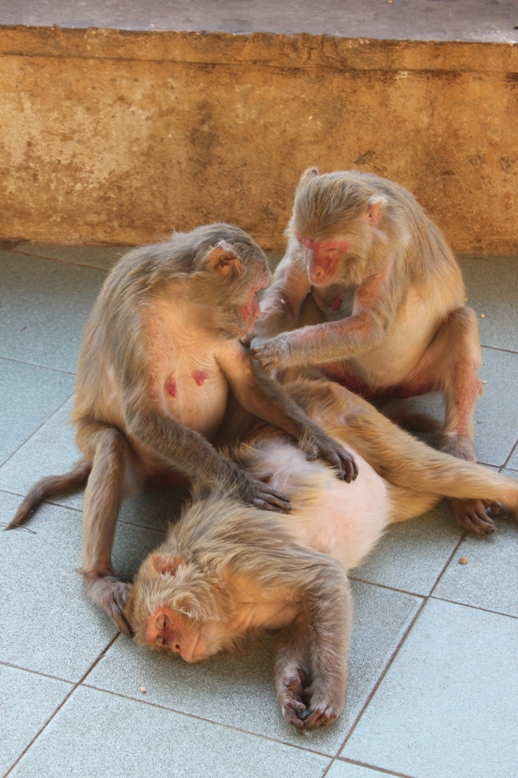 |
| Rhesus macaques relaxing between fights |
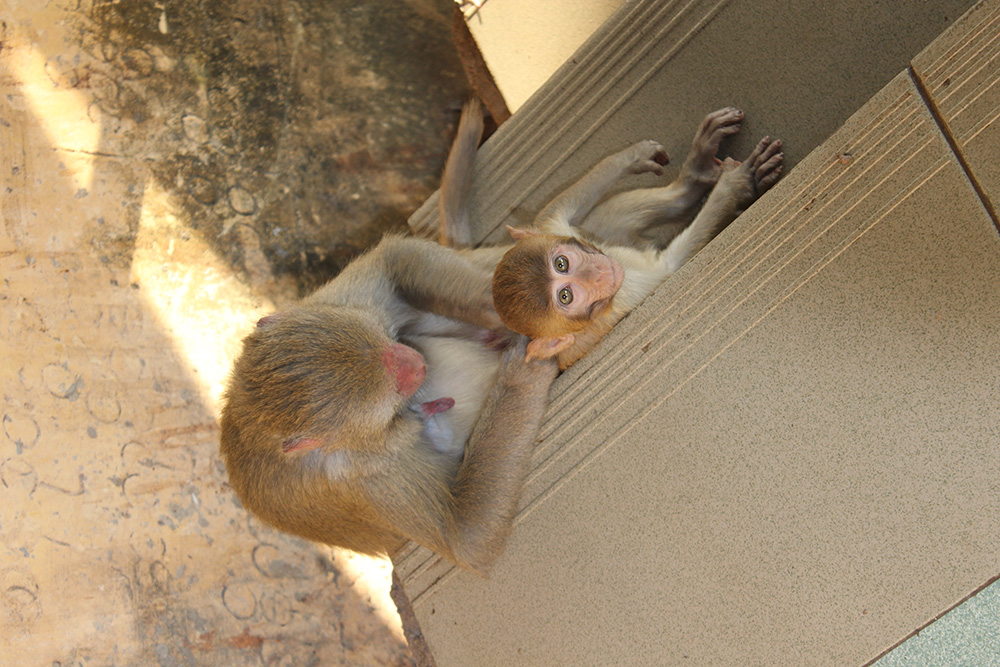 |
| Rich pickings mean there are plenty of youngsters scampering over the crags and buildings of Taung Kalat |
Buddhism here felt glitzy and commercial: there were plenty of desks where you could arrange to make big donations to the temple, and have your name displayed for all to appreciate your generosity. There was an odd array of shrines including some with Hindu influences. An ascetic who wouldn’t have looked out of place in a temple in India paraded the upper part of the temple. A monk wearing an odd vertebra-shaped leathery headdress sat on the smooth white marble. He might have been a hermit, known locally as a yeti.
The view from the stupas was vertigo-inducing. We could see the tastefully disguised Popa Resort nestled in the trees and appreciated the grandeur of the main volcano. Where ancient lava had flowed, it left odd fan-shaped contours, now clad in green. Smoke rose from small bushfires. Immediately beneath us, and in danger of being hit from falling litter thrown by temple visitors, were traders selling fruit, drinks, green coconuts, monkey snacks and tacky souvenirs. But we weren’t allowed to admire the view for long. Locals wanted to be photographed with us and there was always a lot of discussion in how best to arrange their photo-opportunity.
We’d asked the Popa Mountain Resort reception staff for guidance on where we could walk and they gave us a sheet of A4 paper with five lines drawn on it; these seemed to indicate forest paths. Next morning very early, we headed into the forest in a direction compatible with summiting the quarter of a million year old volcano.
Not far from the tarmac road to the hotel, we encountered an odd shrine beside the path. A beautifully painted, solid concrete boat had been built at the foot of a basalt cliff. People brought offerings and prayed there. Black Bulbuls shouted “Look-at-me!” Sunbirds flitted around the low branches, the sun catching the male’s iridescent blue feathers. This was a perfect place to contemplate life and commune with nature, a prospect that seemed more appealing than climbing over a thousand metres to the crater edge.
Onward, the path took us through fine forest. There was no traffic noise. No aircraft. Small creatures scuttled away from us. Unseen birds twittered or called out to us, small wildlife moved the dry leaf-litter close by. Palm squirrels skittered along branches. Light winds moved the air to cool deliciousness.
We came to a junction. Something large moved in amongst the undergrowth. Some low chattering came from the scrub at about chest height, then there was an outbreak of cruel diabolical laughter and I saw a bunch of White-crested Laughing-thrushes flying up to the high branches. I spotted rare Necklaced Laughing-thrushes too. I struck off the path to see what else was in there. People had been working the forest, collecting tamarind. The rustling sounds had been made by humans but they were hiding. Parcels of pods wrapped in cloth, tied to sticks were ready for taking out of the forest.
The five lines on the map didn’t help us navigate and were far from reassuring when the path appeared to head off in the wrong direction, but we walked up, ever up, continuing to try to put names to the birds. Some were familiar from Nepal and India, some were completely new to us. We half remembered calls like the descending whittering sound of the coucal and discussed what else could be here. A few people came by and stopped to watch us watching birds. They seemed amused as we paced around trying to glimpse shy woodpeckers and malcohas. The smiling locals stared for ages, clearly thinking us mad, if amusing.
Big lavish butterflies flitted around us. We expected parakeets. There were none. We expected rhesus macaques and finally spotted one very shy troop. Later, we discovered that a tiny remnant population of endearing but endangered leaf monkeys survive but they must be shier still. There were plenty of places where trees had recently been cut, and there was a dearth of big old trees in this part of the reserve. I wondered how much felling and hunting went on, and what was and wasn’t permitted.
A huge thickened liana dangling at a perfect height to act as a hammock beckoned me. I jumped up onto it and had a swing. My silliness spooked something the size of a muntjac. As it raced away I caught a glimpse of brown deer-fur. Later I spotted some large-bore carnivore poo and knew there was a lot more looking us than we were privileged to see.
Sweat poured as we continued the ascent. Another beautifully marked butterfly landed on me. This time it was on my face. It slurped tears from the corners of my eyes then shifted its attention to my nose. I felt its proboscis tickling the inside of my right nostril as it took a small helping of snot.
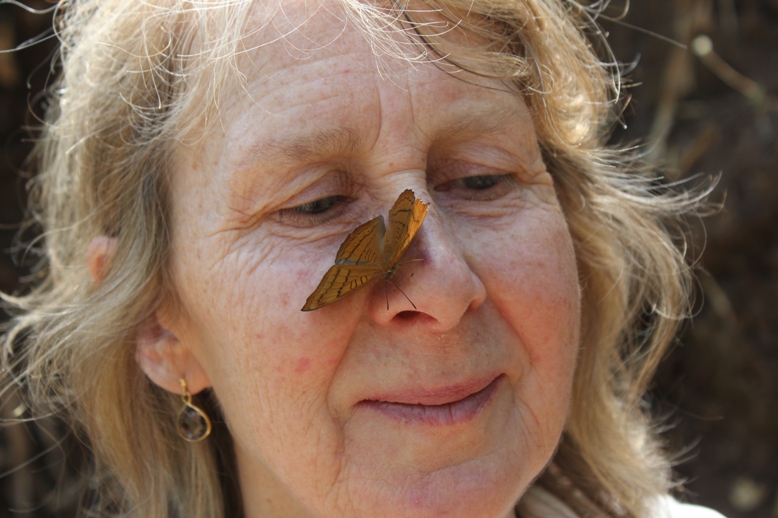 |
| Snot-slurping butterfly |
For much of the climb trees obscured any long distance views but strangler vines, butterflies and flowers were spectacular close-to scenery, and every once in a while we’d break out into a little clearing where a four or five metre high golden stupa had been built. These proved perfect places to sit, gulp down water, rest and listen to birds.
Then when we’d been walking for a couple of hours, we unexpectedly broke out of the forest and saw the crater edge. Invigorated, I strode forward through scrubby vegetation. As I peered inside, a strong destabilising updraft hit me. The inner crater walls were nearly vertical, yet virgin forest clung on there. I was awe-struck by the scale and precipitousness of the volcano.
We slurped down some water and sat enjoying the cooling updraft for a while. We hadn’t reached the top yet. Continuing meant plodding on up and up. To achieve the summit at 1518m we needed to walk steeply up and further round the crater edge. A path continued along the crater wall, snaking away and above us.
The next partial summit comprised a marble terrace overlooked by huge stupa and a microwave mast. A chap, not dressed in the usual wrap-around lungi, but wearing a shirt and trousers, ripped handfuls of red fruit from a wild fig tree, approached us and, picking out the best ones and encouraged us to feast. They were sweet and delicious.
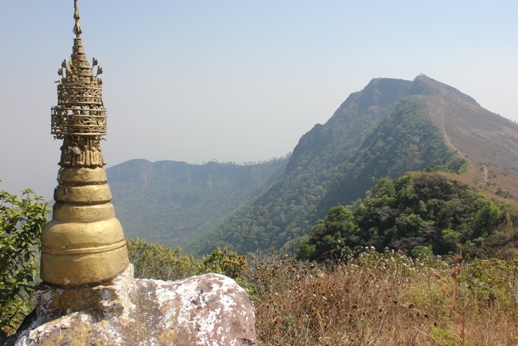 |
| Each of Mount Popa's summits were celebrated with a stupa |
Still we were not at the highest point, but all the other little sub-summits sprouted metre-high white and gold stupas, celebrating achieving a little more altitude. I’d found it hard enough to get myself up to the top of this fine mountain, and didn’t envy the pious people who had tramped up and down carrying rocks and bags of cement to build these celebrations of their Buddhism.
A couple of days later we visited the nearby eco-education centre run by the Ministry of Forests and found a display of easily 100 species of spectacular local butterflies. Several that we’d seen flapping around the forest weren’t represented so I took this to mean there was a truly amazing array of species on Popa. But the resort offered no information on the forest wildlife, there was no bird book, poster or even a bird list there are 177 to be spotted. Staff said that if we wanted to see monkeys we must visit the Taung Kalat temple. I guess they didn’t know about their leaf-monkeys. All over Myanmar you see many, many representations of animals especially in temples, but the animals themselves are not so easy to find any more. I felt saddened that the resort staff seemed to know so little about the rich forest they worked in and profited by and wondered how many actively chosen to work in such a remote but lovely location.
It is a perennial problem; the familiar is seldom valued.